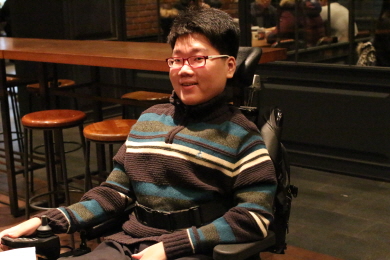
A student in a wheelchair rolls down Nokdu Street near Seoul National University (SNU) is searching for a pub to spend their Friday night with his friends. However, they continue to stop in front of a bar, contemplate for a brief moment, and move on. As time goes by, the joyous mood of the group slightly falters. One girl spots a bar, studies its features, and calls the group to come in. She checks that the wheelchair safely wheels over the flat threshold, removes a chair from the table to give space for the wheelchair, and makes sure that the aisles are wide enough to wheel through. The group settles down at last and enjoys their time. This is what often happens to wheelchair users.
Personally experiencing the inconvenience during his freshman and sophomore years, Kim Chan-gi, a student of SNU, decided to start a project to alleviate these sufferings. As a result, a project to create a map that displays the locations of barrier-free environments, namely Barrier Free Map (BFM), started.
BFM is a map that provides information of stores, cafés, bars and other facilities that satisfy several standards: height of threshold, wide space between tables, mobility of chairs to give space for the wheelchair, and access to restrooms. At first, the map only included the area near SNU, as it was a project of a disability rights school club, Turn to Able. Around 24 students volunteered to collect data of stores around Seoul Nat’l Univ. Station, Nakseongdae Station and Nokdu Street. The map was then distributed via the Facebook page and the magazine of Turn to Able, receiving many positive feedbacks from wheelchair users in the school.
It was then when Kim decided on expanding BFM into a business. Kim realized that the map could help not only students at school but all other wheelchair users in Korea.
Kim’s idea was put into practice, and BFM gained recognition through competitions. It was officially approved as a social enterprise for 2016. As the scale of the map increased along with the size of the business, BFM recruited supporters to collect data around Seoul. More than 70 supporters applied and went around stores in Seoul, taking pictures of the storefront and the interior, as well as checking the aforementioned standards. Despite the fact that BFM was able to accumulate much information thanks to the supporters, there still were some difficulties regarding their activities.
“Many supporters quit early because the work was very emotionally straining,” Kim said. “Many shop owners treated the supporters inhospitably when they tried to take pictures after explaining the project. Some even said that they did not need the disabled at their store.”
However, Kim emphasized that the ultimate role of BFM is not to provide a map with precise locations, but to encourage the users to continuously update the map. He explained that even though the concept of barrier-free map is not new, the application is different from the existing ones.

“An application that is not constantly updated is a dead one,” Kim stressed. “When there are stores going out of business and stores newly opening every day, it is impossible to track the changes solely with the manpower of the company. It is essential that the users all over the country share the information and update the application themselves.”
The application has features such as searching barrier-free places through words and by screening the area around the user’s location, and adding a new location with photos and information of certain standards. The development is nearly complete, save for installing the collected data in the map, beta testing and reflecting the feedbacks. Kim aims to release it in late December or in January 2016.
“The goal of BFM is to reach a point where barrier-free maps are not needed anymore,” Kim said. “If the application becomes well known and the concept of barrier-free spreads widely, movements to improve the interior of places might occur. We hope that all places eventually become barrier-free so our application becomes useless.”
In addition to BFM, Kim has more business ideas that corresponds with the slogan of BFM: Construct a society with no physical barriers via the power of information technology. For example, he is forming an idea of a pedestrian navigation application for wheelchair users as the established navigations occasionally fail to guide an accessible path. In many cases, wheelchair users have to make a detour to avoid bumps on the roads or stairs. Kim thinks that under the agreement of information provision, it would be possible to gather the big data of roads that wheelchair users frequently utilize and create a navigation for wheelchair users.
Kim highlights that it is important that people without disabilities also take interest in such matters.
“People without disabilities do not think of the difficulties the disabled go through in their daily lives,” Kim said. “However, you could be in a wheelchair tomorrow, and there might be a friend or family who uses a wheelchair. Please consider these problems not as someone else’s but as your own.”

